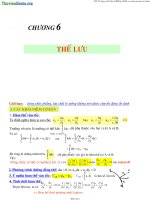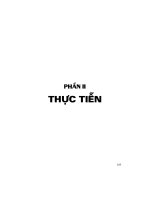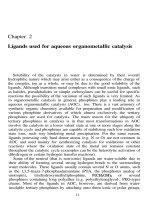Tài liệu Chapter 8 :Multiplexing pdf
Bạn đang xem bản rút gọn của tài liệu. Xem và tải ngay bản đầy đủ của tài liệu tại đây (366.96 KB, 38 trang )
William Stallings
Data and Computer
Communications
Chapter 8
Multiplexing
Multiplexing
Frequency Division Multiplexing
❚
FDM
❚
Useful bandwidth of medium exceeds required
bandwidth of channel
❚
Each signal is modulated to a different carrier
frequency
❚
Carrier frequencies separated so signals do not
overlap (guard bands)
❚
e.g. broadcast radio
❚
Channel allocated even if no data
Frequency Division Multiplexing
Diagram
FDM System
FDM of Three Voiceband Signals
Analog Carrier Systems
❚
AT&T (USA)
❚
Hierarchy of FDM schemes
❚
Group
❙
12 voice channels (4kHz each) = 48kHz
❙
Range 60kHz to 108kHz
❚
Supergroup
❙
60 channel
❙
FDM of 5 group signals on carriers between 420kHz and
612 kHz
❚
Mastergroup
❙
10 supergroups
Synchronous Time Division
Multiplexing
❚
Data rate of medium exceeds data rate of digital
signal to be transmitted
❚
Multiple digital signals interleaved in time
❚
May be at bit level of blocks
❚
Time slots preassigned to sources and fixed
❚
Time slots allocated even if no data
❚
Time slots do not have to be evenly distributed
amongst sources
Time Division Multiplexing
TDM System
TDM Link Control
❚
No headers and tailers
❚
Data link control protocols not needed
❚
Flow control
❙
Data rate of multiplexed line is fixed
❙
If one channel receiver can not receive data, the others
must carry on
❙
The corresponding source must be quenched
❙
This leaves empty slots
❚
Error control
❙
Errors are detected and handled by individual channel
systems
Data Link Control on TDM
Framing
❚
No flag or SYNC characters bracketing TDM
frames
❚
Must provide synchronizing mechanism
❚
Added digit framing
❙
One control bit added to each TDM frame
❘
Looks like another channel - “control channel”
❙
Identifiable bit pattern used on control channel
❙
e.g. alternating 01010101…unlikely on a data channel
❙
Can compare incoming bit patterns on each channel
with sync pattern
Pulse Stuffing
❚
Problem - Synchronizing data sources
❚
Clocks in different sources drifting
❚
Data rates from different sources not related by
simple rational number
❚
Solution - Pulse Stuffing
❙
Outgoing data rate (excluding framing bits) higher than
sum of incoming rates
❙
Stuff extra dummy bits or pulses into each incoming
signal until it matches local clock
❙
Stuffed pulses inserted at fixed locations in frame and
removed at demultiplexer
TDM of Analog and Digital
Sources
Digital Carrier Systems
❚
Hierarchy of TDM
❚
USA/Canada/Japan use one system
❚
ITU-T use a similar (but different) system
❚
US system based on DS-1 format
❚
Multiplexes 24 channels
❚
Each frame has 8 bits per channel plus one
framing bit
❚
193 bits per frame
Digital Carrier Systems (2)
❚
For voice each channel contains one word of
digitized data (PCM, 8000 samples per sec)
❙
Data rate 8000x193 = 1.544Mbps
❙
Five out of six frames have 8 bit PCM samples
❙
Sixth frame is 7 bit PCM word plus signaling bit
❙
Signaling bits form stream for each channel containing
control and routing info
❚
Same format for digital data
❙
23 channels of data
❘
7 bits per frame plus indicator bit for data or systems control
❙
24th channel is sync
Mixed Data
❚
DS-1 can carry mixed voice and data signals
❚
24 channels used
❚
No sync byte
❚
Can also interleave DS-1 channels
❙
Ds-2 is four DS-1 giving 6.312Mbps
ISDN User Network Interface
❚
ISDN allows multiplexing of devices over single
ISDN line
❚
Two interfaces
❙
Basic ISDN Interface
❙
Primary ISDN Interface
Basic ISDN Interface (1)
❚
Digital data exchanged between subscriber and
NTE - Full Duplex
❚
Separate physical line for each direction
❚
Pseudoternary coding scheme
❙
1=no voltage, 0=positive or negative 750mV +/-10%
❚
Data rate 192kbps
❚
Basic access is two 64kbps B channels and one
16kbps D channel
❚
This gives 144kbps multiplexed over 192kbps
❚
Remaining capacity used for framing and sync
Basic ISDN Interface (2)
❚
B channel is basic iser channel
❚
Data
❚
PCM voice
❚
Separate logical 64kbps connections o different
destinations
❚
D channel used for control or data
❙
LAPD frames
❚
Each frame 48 bits long
❚
One frame every 250µs
Frame Structure
Primary ISDN
❚
Point to point
❚
Typically supporting PBX
❚
1.544Mbps
❙
Based on US DS-1
❙
Used on T1 services
❙
23 B plus one D channel
❚
2.048Mbps
❙
Based on European standards
❙
30 B plus one D channel
❙
Line coding is AMI usingHDB3
Primary ISDN Frame Formats
Sonet/SDH
❚
Synchronous Optical Network (ANSI)
❚
Synchronous Digital Hierarchy (ITU-T)
❚
Compatible
❚
Signal Hierarchy
❙
Synchronous Transport Signal level 1 (STS-1) or Optical
Carrier level 1 (OC-1)
❙
51.84Mbps
❙
Carry DS-3 or group of lower rate signals (DS1 DS1C
DS2) plus ITU-T rates (e.g. 2.048Mbps)
❙
Multiple STS-1 combined into STS-N signal
❙
ITU-T lowest rate is 155.52Mbps (STM-1)









